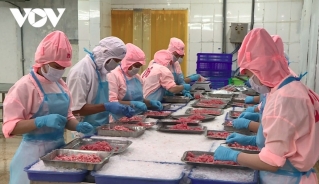Export of aquatic products tops US$774 million in January
Vietnam shipped US$774.3 million worth of aquatic products abroad in January, a year-on-year increase of 3.3%, according to the Vietnam Association of Seafood Exporters and Producers (VASEP).
This growth is noteworthy given that it coincided with the Lunar New Year holiday.
Shrimp continued to lead the sector, generating US$300 million in revenue and accounting for 39% of the total export.
VASEP Communications Director Le Hang cited a recent report from the Netherlands’ Rabobank as showing that the global shrimp industry is in a rebalancing phase, with production growth expected to slow across major producers who are working to narrow the supply – demand gap. This will lead to gradual price recovery in the first half of this year, particularly as demands from the US and the EU improve.
However, consumption is falling in China, one of the major destination for Vietnamese shrimp. Changes in the middle class’s spending habits and income pressures have resulted in a decline in white shrimp consumption, particularly in major cities. Competition from cheaper seafood alternatives and shifting food preferences are expected to impact shrimp exports to China in the coming months.
In the meantime, tra fish export faced challenges in January, with revenue falling over 25% to US$123 million despite higher prices driven by shortage of supply.
Enterprises are expecting a growth in tra fish export to US on the back of a bilateral agreement signed on January 17 to remove anti-dumping duties on Vietnamese fish fillet. This deal marked the end of the dispute in Case DS536 at the World Trade Organisation (WTO) since 2018.
Tuna exports recorded over US$65 million in January, down 17.7% year-on-year. However, stable growth in consumption from key markets like the US and EU offers hope for recovery throughout 2025. The sector could benefit from tariff policy changes, particularly in the US market, potentially making Vietnamese tuna more competitive against other imports, according to VASEP.
Market performance varied significantly across regions. While exports to China (including Hong Kong) surged by 64.9%, the US and EU markets declined by 16% and 17.6%, respectively. ASEAN markets showed steady growth at 10.5%, highlighting Southeast Asia's potential as a bright spot for the export of Vietnamese aquatic products.
Looking ahead, the industry will face the challenge of adapting to changing consumer habits, tariff policies, and supply-demand fluctuations in the global market. VASEP said the sector’s success in 2025 will largely depend on developing value-added products, improving product quality, and diversifying export markets to ensure sustainable growth.



